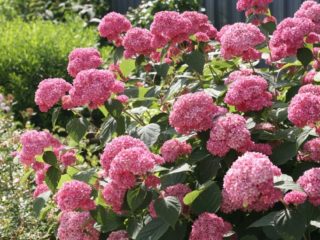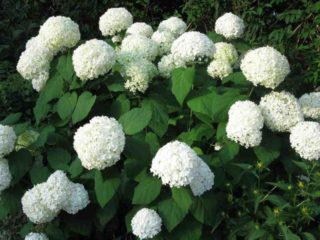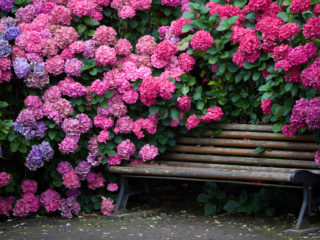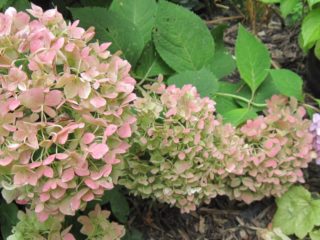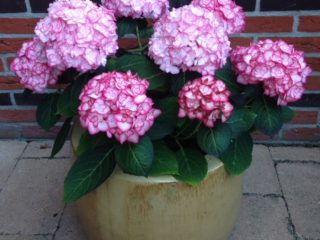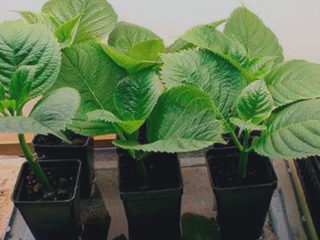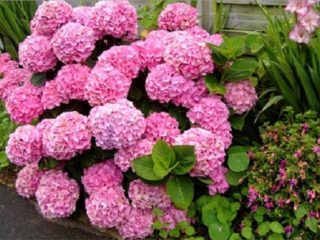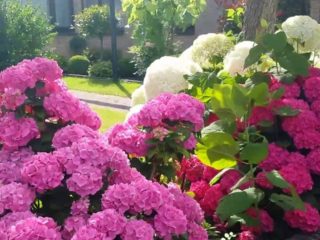Content
Hydrangea White Lady is well known to the residents of our country; it grows in all parts of Russia. Even novice gardeners can handle caring for flowering shrubs. The unpretentious plant does not require special conditions for growth, which means it will decorate any area.
Description of Hydrangea Paniculata White Lady
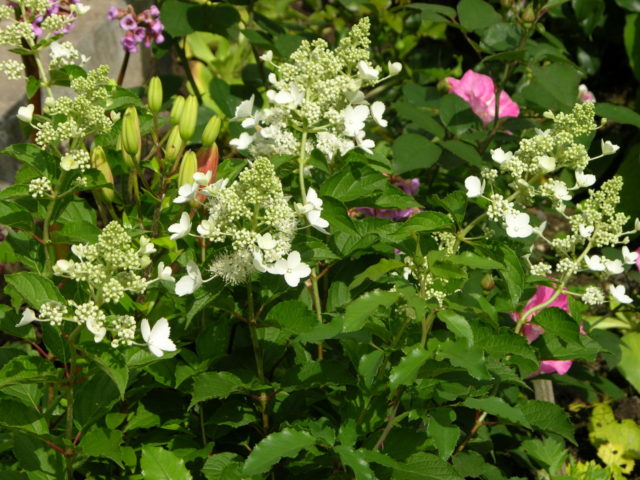
Blooming Hydrangea White Lady will enliven any garden plot
The plant is a shrub reaching a height of 3 m. It is distinguished by a lush, spreading crown. The shoots have a brownish tint.
The leaves are shaped like an egg. They are a little rough, the edges are jagged.
The inflorescences are collected from large buds, which are assembled in such a way that the flower has a trapezoid shape.
At the beginning of flowering, the buds are white, later they turn pink. By this sign it is possible to determine how long the bush blooms.And the plant delights with its beauty for a long time: from the beginning of the summer season until the fall.
Hydrangea White Lady in landscape design
Designers appreciated the decorative qualities of the plant. Hydrangea White Lady is planted in landscape areas as part of other flowering plants or as a single option for decorating a site.
Hydrangea goes perfectly with roses of all varieties, irises, and green shrub-type plants.
Hydrangea bushes are also used as hedges. This application is possible due to the height of the plant.
Winter hardiness of Hydrangea paniculata White Lady
Hydrangea paniculata White Lady was loved for its unpretentiousness. This is a frost-resistant plant. It can withstand temperatures down to -30 degrees. Thanks to this feature, the shrub easily copes with the climate typical for Russia.
Planting and caring for Hydrangea paniculata White Lady
Even a novice gardener can handle planting and care. To make the plant happy with its blooming appearance, it is enough to follow the simplest rules.
Selection and preparation of a landing site
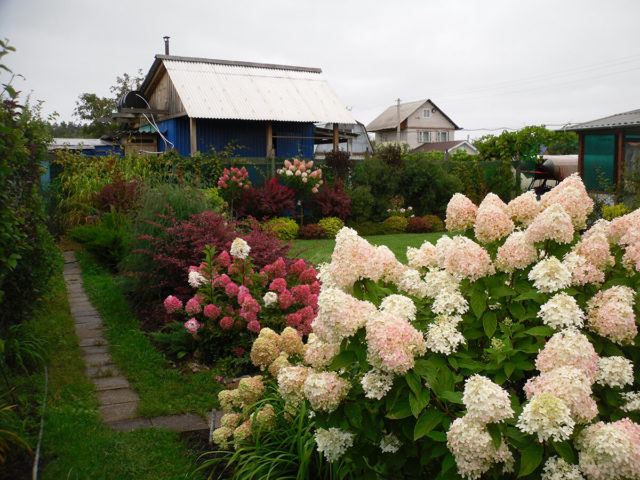
It is important that the area where the shrub will grow is well lit
It is enough to plant an unpretentious hydrangea in an open, illuminated area. There is no need to select special sites.
Flower growers recommend paying attention to the quality of the soil. Light, nutrient-rich soil is considered ideal. The soil must contain:
- peat;
- sand;
- humus.
If the soil is not good enough, a composition consisting of the above elements is poured into the hole in which the plant will be planted.
Landing rules
Hydrangea seedlings are placed in pre-prepared holes (holes). Dimensions:
- depth – 0.3 m;
- width – 0.4 m.
The distance between the holes should be at least one and a half meters, since subsequently the plant will have a spreading crown.
Choose healthy, strong seedlings. This ensures their subsequent growth. The roots must be straightened and only then covered with soil.
After planting, watering is carried out. For one sprout, 5 liters of water at room temperature is enough.
Watering and fertilizing
White Lady hydrangea care includes:
- watering;
- feeding;
- loosening the soil;
- removing weeds.
It is necessary to water the White Lady white hydrangea weekly, 10 liters of water for each bush is enough.
Feeding is done as follows:
- 7 days after planting the seedling, the plant is watered with a KNO₃ solution at the rate of 0.1 kg per 4 liters of water.
- After 21 days, the soil under the bush is watered with a humus solution. It is enough to infuse 2 kg of fertilizer in a bucket of water.
- At the beginning of autumn, hydrangea is watered with a solution of mineral phosphorus fertilizer at the rate of 0.2 kg per 5 liters of water.
- In the spring, after the snow has melted, the bush is additionally watered with a solution of NH₄NO₃ (ammonium nitrate). In this case, 0.1 kg of saltpeter is dissolved in 10 liters of water.
This feeding is enough to make the White Lady hydrangea feel comfortable.
Pruning Hydrangea paniculata White Lady
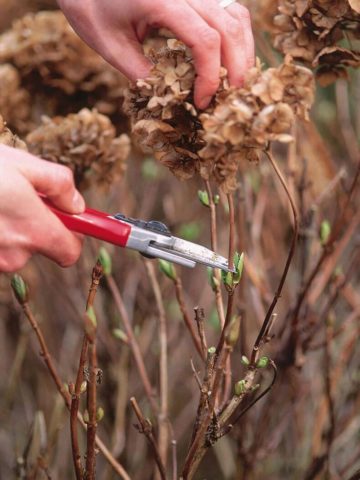
Dry branches and inflorescences should be removed in spring and autumn
Hydrangea Paniculata White Lady is pruned twice a year: in autumn and spring.
With the onset of cold weather, it is recommended to cut off all the inflorescences and shorten the shoots so that 4 to 7 buds remain (in total, up to 30 cm of shoots need to be cut off).
This is done in order to preserve nutrients, which will later be used to combat frost.
With the onset of spring days, the bush should be inspected with special attention. Dry branches and remaining inflorescences are cut off. This way the hydrangea will recover before flowering begins.
Preparing for winter
The opinions of flower growers on how to properly prepare a plant for winter are divided. Some lovers believe that paniculata hydrangea must be covered to protect it from frost. Other gardeners don't do this.
In northern regions, which are characterized by long and severe frosts, it is recommended to cover the bush with straw or hay.
You must also follow the following recommendations:
- Stop watering when cold weather sets in.
- Remove foliage, inflorescences, shorten shoots.
- Water the soil with a solution of fertilizers that contain phosphorus and potassium (before the onset of frost).
These recommendations will help keep the plant healthy until spring.
In the southern regions, it is enough to hill up the bush to protect the roots from frost on the soil, or cover the plant with straw. It is also possible to sprinkle the soil near the root system with sawdust.
Reproduction
Seedlings are bought in specialized stores or prepared independently.
Hydrangea White Lady is propagated by dividing the bush. A healthy bush is dug up in the fall and divided into several equal parts. It is important to preserve the root system, so you need to dig out the bush carefully.
Then the bushes are soaked in a solution of Karbofos (sold in stores) and kept in fertilizer for up to 3 days. This allows the roots to be nourished with the necessary elements.
The bushes are stored in a cool, dark room (basement, cellar), and in the spring they are planted in prepared holes separately according to the recommendations of experts.
Diseases and pests
Hydrangea White Lady needs to be protected from pests and protected from characteristic diseases.
This plant variety is susceptible to chlorosis and powdery mildew.
Signs of incipient chlorosis include wilting of foliage, yellowing, and pronounced small inflorescences. To prevent the consequences of the disease, the bush is watered with a solution containing iron salts.
Powdery mildew appears as a result of excessive watering. It is impossible to get rid of dew. It is important to regulate watering.
Hydrangea White Lady is also protected from pests:
- spider mite;
- meadow bug;
- leaf aphids.
“Karbofos” (100 g per half bucket of water) will protect the bush from bugs and ticks. The plant is treated with this solution as soon as the owner detects the first signs of pest activity. Without treatment, the risk that the hydrangea will die increases.
Aphids are afraid of Oxychoma. The bush is watered with a solution at the rate of 30 g of fertilizer per 6 liters of water.
As a result of frequent and abundant watering (or a rainy summer), slugs may appear on Hydrangea paniculata White Lady white. Fitoverm will help get rid of pests (calculated at 0.1 kg per 5-6 liters of water).
"Aktellik" is used in areas that snails love. The area is sprayed with a solution at the rate of 90 g per 3-4 liters of water. Processing is carried out weekly.
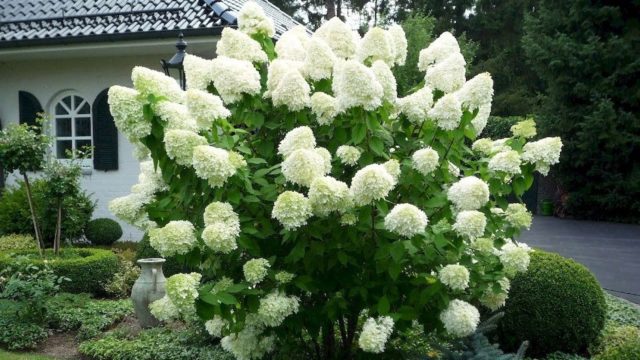
Hydrangea paniculata White Lady is ideal for growing in Russia
Conclusion
Hydrangea White Lady tolerates the Russian climate well. The shrub is frost-resistant; it is not afraid of the low temperatures characteristic of our region.
Novice flower growers and landscape designers can begin to master the basics of gardening by planting and caring for this crop. The reward will be a blooming, fragrant plot.

